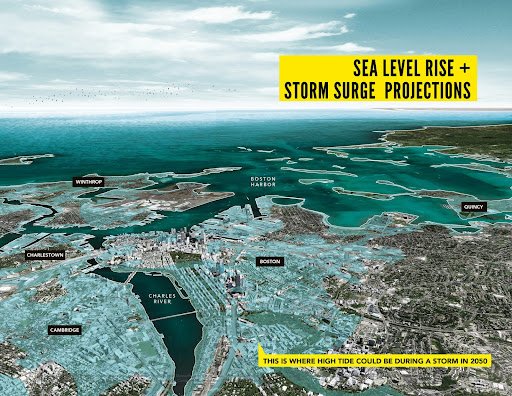by Rachel Cerato
When you think of resilience, what comes to mind? The typical definition of resilience describes something that can adapt or recover quickly from difficult situations and return to the “pre-crisis” status quickly. This is an approach that is becoming increasingly necessary as climate threats are already here. In Boston, for example, 7 percent of land area is likely to be threatened by stormwater flooding by 2050. Boston residents may also remember the unbearable heat waves of Summer 2022, which set a record for the hottest 30-day stretch in Boston history!
Sea level rise and storm surge projections by 2050 in Boston. Image from Sasaki.
Resilience is such a big concept that it can be difficult to understand in relation to climate action and preparedness. We should think of two separate buckets when it comes to this topic: energy resilience and community resilience. According to Centrica, energy resilience is “a reliable, regular supply of energy and [emergency] measures put in place in the event of a power failure.” But, an often forgotten part of climate preparedness is community resilience. RAND describes community resilience as “the ability of a community to utilize available resources to respond to, withstand, and recover from adverse situations.” Those may seem very similar, and they are! The difference is that community resilience focuses on resources and recovery beyond just energy; this can include food systems, transportation, jobs, and general well-being.
Energy and community resilience are similar concepts but can mean different things in times of emergencies and power outages. Check out this graphic to see the different responses between the two! Image from Climable.
So, let’s talk about energy resilience. If your community experiences stormwater flooding, for example, the power may go out. Maybe you have a generator, but only 15% of Americans currently have personal backup power. That means that once the power goes out, it’s out for however long it takes the utility provider to fix the problem. This means that your electricity, water, and internet may be down for an unknown amount of time. In a longer outage, your food may spoil in the fridge, and if you have medications that need to be refrigerated, they may go bad. If you live far from family, you may not be able to get in touch with them to make sure they’re okay. And if it’s super hot or super cold, without heating or cooling systems, you could be at risk of hypothermia or heat stroke. Now, that may sound scary. And it is! That’s why we need resilience: so that when emergencies happen, we’re prepared to persist, recover, and ensure that the most vulnerable have their needs met.
Although generators are a common form of individual backup energy, which we need for energy resilience, they don’t fully fix the problem. Generators, especially older ones, release fossil fuel emissions and can create health risks if not they’re not properly ventilated or installed. This creates a cycle of problems: when facing climate emergencies, a generator releases more fossil fuel emissions, which contributes to climate change, and will cause more climate emergencies!
But don’t be discouraged! Energy resilience _is_ possible, and there’s progress and action happening every day. But what’s the next step? What ideas do you have for how to integrate energy resilience into the existing system? Tune in for the next part of this blog series to learn more about energy resilience and one of our favorite topics here at Climable: microgrids!




